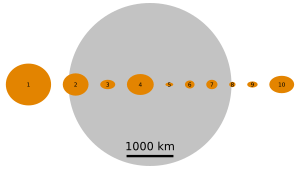5 Astraea facts for kids
| Discovery | |
|---|---|
| Discovered by | Karl Ludwig Hencke |
| Discovery date | December 8, 1845 |
| Designations | |
| 1969 SE | |
| Main belt | |
| Orbital characteristics | |
| Epoch November 26, 2005 (JD 2453700.5) | |
| Aphelion | 459.202 Gm (3.070 AU) |
| Perihelion | 310.688 Gm (2.077 AU) |
| 384.945 Gm (2.573 AU) | |
| Eccentricity | 0.193 |
| 1507.676 d (4.13 a) | |
|
Average orbital speed
|
18.39 km/s |
| 194.442° | |
| Inclination | 5.369° |
| 141.690° | |
| 357.530° | |
| Physical characteristics | |
| Dimensions | 167×123×82 km |
| Mass | ~2.4×1018 kg |
|
Mean density
|
~2.7 g/cm³ |
| ~0.023 m/s² | |
| ~0.062 km/s | |
| 0.700 03 d (16.801 h) | |
| Albedo | 0.227 (geometric) |
| Temperature | ~167 K max: 263 K (-10 °C) |
|
Spectral type
|
S-type asteroid |
| 8.7 to 12.92 | |
| 6.85 | |
| 0.15" to 0.041" | |
5 Astraea (also spelled Astræa in older writings) is a large main belt asteroid. Its surface is very bright, meaning it reflects a lot of sunlight. Scientists believe it is made of a mix of nickel-iron and rocky materials like magnesium- and iron-silicates.

Contents
Discovering Astraea
Astraea was the fifth asteroid ever found. It was discovered on December 8, 1845, by an amateur astronomer named Karl Ludwig Hencke. He worked at a post office and loved looking at the stars.
Hencke's First Find
Hencke was actually searching for 4 Vesta, another asteroid, when he accidentally found Astraea. This was his first of two asteroid discoveries. His second discovery was 6 Hebe. The King of Prussia was so impressed that he gave Hencke an annual payment of 300 US dollars (which was a lot of money back then!).
Astraea's Place in Space
Astraea spins in a forward direction, which is called prograde rotation. Its north pole points towards a specific spot in the sky. This means it has a tilt of about 33 degrees, similar to how Earth is tilted on its axis.
Why Astraea is Special
Even though Astraea isn't the brightest or biggest asteroid, its discovery was a huge deal. For 38 years before Astraea was found, people thought there were only four asteroids in space. These four were even considered planets at the time!
Astraea's discovery showed that there were many more objects in the asteroid belt. This led scientists to realize that the first four "planets" were actually just the biggest of a whole new group of space rocks. After Astraea, thousands more asteroids were found.
A Rare Event
On February 2, 1991, Astraea passed directly in front of a distant star. This event, called a stellar occultation, is very rare. It allows scientists to learn more about the asteroid's size and shape.
See also
 In Spanish: (5) Astraea para niños
In Spanish: (5) Astraea para niños

